Paper Doll
Paper Doll Models the Spring 2021 Organizing Products
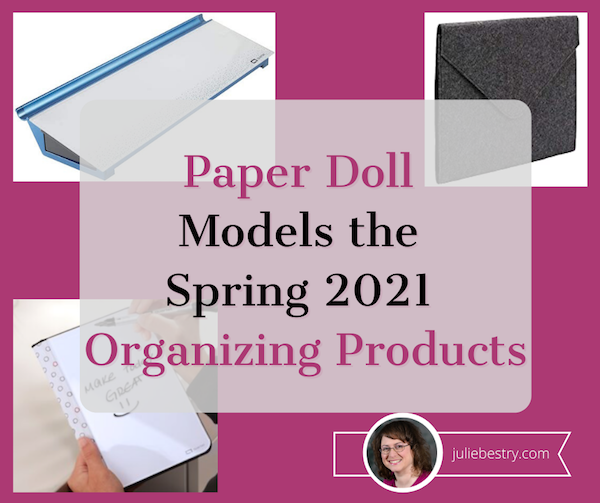
It’s finally springtime, the perfect time for new organizing supplies!
For most of the fourteen years I’ve been writing this Paper Doll blog, I’ve delighted in sharing new organizing products displayed at the annual NAPO Conference & Expo. Unfortunately, last year, the conference was canceled due to COVID. This year, although we’re very excited that we will get to have a 2021 NAPO Conference (albeit virtually) next month, there will not be an expo.
However, that doesn’t mean you’ll miss out on new organizing products! I’ve been collecting tidbits and emails over recent months, enough to assure you that there are novel and interesting organizing products out there in the world, and today, we’ll look at a few of them.
Organize Your Papers & Information
Whether you feel like you’re working from home or living at the office, whether “work” is your career or your volunteer gig or having a serious meeting at your kids’ school, the business of your life involves a lot of moving parts. Let’s look at what make these efforts run more smoothly.
Smead Soft Touch Cloth Expanding Files
Right now, most people’s “meetings” are held virtually, with each person in his or her own Brady Bunch-style box on Zoom or the equivalent. As long as we’re dressed from the waist up and have combed our hair, we pass muster. Nobody can see much below our shoulders, so if we’ve scribbled our notes on a Snoopy memo pad, our co-workers won’t be able to tell.
But imagine someday soon, it will be like the “before times” – eventually, we’ll all be back in the “real” world, with in-person meetings. And for good or ill, style will matter, at least a little, and we won’t be able to just carry an armload of papers as we might do now, from couch to desk. Somehow, I suspect our old briefcases will seem stodgy, a remnant of another era, but backpacks will feel just a little too casual for a meeting with the CEO. Smead has found a middle path.
Paper Doll’s Tax-Smart Organizing Tips: 2021
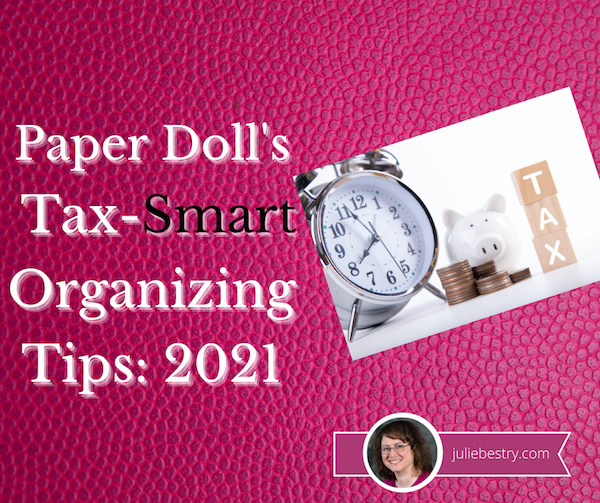
Photo by Khaosai Wongnatthak at Vecteezy
I know this will be hard to believe, but “doing” your income taxes does not have to be painful. (Paying your taxes is another issue altogether.) The key to succeeding is, no surprise, getting organized — knowing what information you need, what specific forms to expect, and having it all ready when the questions are asked.
Today’s post will give you some guidance regarding what you need to organize to get your taxes completed. But first, you should be aware of some important news regarding preparing your 2020 tax return.
TAX NEWS YOU CAN USE TO KEEP ORGANIZED
Tax Deadline Changed
Most years, Tax Day is April 15th, give or take a day for weekends or special holidays. (For example, in 2023, April 15th falls on a Saturday, so Tax Day would normally be April 17th, the following Monday. However, that’s Patriots’ Day in Massachusetts, Maine, and several other states, so Tax Day will be April 18, 2023, nationally.) In 2020, due to the pandemic, the IRS moved the federal Tax Day forward to July 15, 2020, and most states delayed their tax filings, too.
Last week, after leaving people guessing for several months, the IRS announced that Tax Day 2021 has been delayed one month to Monday, May 17, 2021.

Note: this extension only refers to individual tax returns; federal estimated quarterly payments and other federal tax deadlines haven’t changed. Thirteen states have already changed their tax deadlines to May 17, 2021, with more considering a change, so please consult your own state’s revenue department websites for up-to-date information in your state.
I encourage you to pretend that the IRS did not delay the date, and use this as an opportunity to set up small blocks of time, even 20 minutes each evening over the course of a week or so, to gather your resources. If you work on your taxes in small chunks of time, bit by bit, it won’t seem so overwhelming. Again, once you have all the information, it’s just about being able to answer the questions.
Unemployment Funds “Bonus”
Did you receive unemployment benefits during 2020? (You should have a 1099-G if you did!) Many Americans did, including self-employed individuals who had never been able to collect unemployment previously. Often, people are so relieved to receive these funds that they do not consider that unemployment payments are taxable and they do not opt to have taxes deducted, assuming (or hoping) that by April of the next year, their financial fortunes will have improved. This can be problematic even when there isn’t a global pandemic going on!
If you did not think about paying taxes on that compensation, there’s a little good news. Although it’s really rare for this kind of retroactive relief, as part of the American Rescue Plan of 2021, the first $10,200 of unemployment benefits earned in 2020 will not be taxable for people with incomes of less than $150,000.
Last week, most of the online tax preparation companies updated their software to adjust for this. If you started doing your taxes weeks or days ago but didn’t finish, when you log in you may be surprised to see that your amount owed is lower or your refund is higher. Whoohoo!

Nick Youngson via CC BY-SA 3.0 Alpha Stock Images
Are you Old School? Do you do your taxes on paper? The IRS has released instructions and a worksheet for taking advantage of that $10,200 exclusion for unemployment compensation. (Cheatsheet: you’re going to focus on line 7 of your 1040!)
What if you already filed your taxes? You may be thinking that you’ll have to file an amendment to your tax return in order to get money refunded to you. Not so fast! Hold your horses!
The IRS has stated that individuals who have already filed their returns and who paid taxes on their unemployment benefits (either through them being taken out by their states or on their recently-filed returns) should NOT amend their returns. Rather, the IRS will be recalculating those returns and money will be refunded to individuals by direct deposit or check, depending on their circumstances.
Again, for those of you in the back, still high-fiving about this income not being taxable: the IRS will automatically process refunds to account for the first $10,200 in unemployment benefits! Don’t amend your taxes for this!
Stimulus Not Taxable
You may have received a federal stimulus check in 2020, $1200 for each individual under a certain income threshold plus $500 for each dependent child. Your stimulus payment is NOT taxable. Why? Because, due to the way the law was written, stimulus checks are not considered “income.” Rather, they are advance payments of a tax credit, and tax credits aren’t taxable income.
However, if you were eligible but did not receive your stimulus check, you will be able to report that fact on your return to apply it toward your taxes owed or refund due. You do this by claiming the Recovery Rebate Credit. Your accountant or tax software will know how to handle this, but keep your eye on line 30 of your 1040 form. (Do you like reading the nuts and bolts? Check out page 58 of the IRS tax instructions for the Recovery Rebate Credit worksheet.)
Earned Income Tax Credit (EITC) Option
Those of you who earned less in 2020 than in 2019 (and that includes a lot of people) have a delightful surprise awaiting you. When doing your 2020 taxes, you have the option of using either your 2020 or 2019 income to calculate your Earned Income Tax Credit.

Special Forms for Seniors
Are you a senior? As of last year, if you are over 65, instead of filing the standard 1040 form, you can file the 1040-SR. The main benefit is that this form, when printed, uses a larger font and provides easier readability.
New Kind of 1099 for Freelancers
In the past, freelancers, independent contractors, and similar non-employees received the 1099-MISC — you know how organizers feel about a “miscellaneous” category! This year, there’s a new form, the 1099-NEC for non-employee compensation. (See below for more on this new form.)

Photo courtesy of Chris Potter/CCPix at www.ccPixs.com under CC 2.0
KNOW WHAT YOU SPENT
The best time to get ready for doing your taxes in 2021 was back in early 2020, but something tells me you were a little distracted by world events and trying to buy toilet paper. To file your taxes for this most wackadoodle of years, you’re going to have access a lot of information about your 2020 spending, like:
- receipts for tax-deductible purchases (check for paper receipts as well as email confirmations of purchases)
- statements for ongoing accounts
- an online financial dashboard (like Quicken, Mint, Personal Capital, or YNAB)
If you made a lot of Amazon purchases this year (and really, who didn’t?), especially if you are self-employeed and can expense office supplies and other work-related items, you can select “2020” from the drop-down section under Your Orders in your Amazon account; digital orders (such as for educational materials) have their own drop-down, three tabs to the right. To download your entire Amazon order history, go to the Amazon Request My Data page.
Gather all your tangible information in a folder labeled Tax Prep 2020, or use something like the Smead All-In-One Income Tax Organizer. Just having it all together will be the first step toward tabulating the correct amounts.
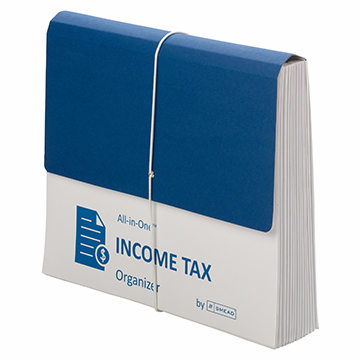
GATHER YE FORMS
Of course, most of the big-ticket items you’ll be entering into tax software (or, gulp, on paper forms) comes not from the little receipts and statements you get during the year, but from the official forms you receive.
It all starts with the supporting documents called information returns. These are sent to you by others – employers, banks, brokerage houses, schools, casinos, and others. The law requires these entities to send them to you by February 1, so you shouldn’t have to do much searching. They should have shown up in your mail. So that scary-but-official mail you threw on top of the microwave the week before Valentine’s Day? Move the oven mitts and get looking!
MONEY YOU RECEIVED
W-2 (Wage and Tax Statement)
Did you have an employer in 2020 (even for part of it)? Then you should have received a W-2. Your employer is supposed to send one copy to you and one to the IRS, reporting how much you were paid (in wages, salaries, and/or tips). If applicable, it should also indicate how much money was withheld from you and paid to federal and/or state governments for taxes and FICA (Social Security and Medicare).
Federal, state, and local taxes, FICA, unemployment insurance, and a few other withholdings are considered statutory payroll tax deductions. Statutes (that is, laws) require them. Duh!
Sometimes, a court might rule that an an employee’s wages may be garnished, but this has nothing to do with sprigs of parsley. People behind on child support payments or who owe money in lawsuits may have money removed from their earnings, before it ever gets to their paychecks, to ensure it goes directly to whomever is owed.
Your W-2 may also report voluntary payroll deductions. These are amounts withheld from your paycheck because you’ve granted permission. These may include your portion of health and life insurance premiums, contributions to your 401(k) or other retirement fund, employee stock purchasing plans, one-time or ongoing donations to the United Way, union dues, etc.

Photo by The New York Public Library on Unsplash
You probably got multiple copies of the same W-2. Employers submit copy A directly to the Social Security Administration (remember that FICA we talked about?) and keep copy D for their own records. Copies B and C are for you (the employee) – you send one to the IRS with your federal tax return and keep one for your own records. Then, copies 1 and 2 are provided to file with any applicable state or local tax authorities. (I’ve never figured out why W-2 copies 1 and 2 aren’t called E and F. Did the same person who came up with this decide that bras should be sized as A, B, C, D, DD, DDD, F, FF, and G, skipping E entirely?)
I've never figured out why W-2 copies 1 and 2 aren't called E and F. Did the same person who came up with this decide that bras should be sized as A, B, C, D, DD, DDD, F, and G, skipping E entirely? Share on XIn theory, a W-2 should be mailed to the address listed on your W-4. (Don’t be confused. The W-4, is the form that tells your boss how much to withhold based on your number of dependents you have an any necessary adjustments.) Many smaller companies don’t bother mailing the W-2 and just hand them to you, but given how many people are still working from home and how iffy the postal service has been (cough, cough), you might have to Zoom or send an email to Madge in HR. Some things to consider:
- Did you change employers last year? You should have received W-2s from each employer. (If you changed jobs at the same company, you’ll receive one W-2 from each employer, not one per position. If you changed companies within a larger corporation, though, you may get one for each.)
- Did you change addresses since you filled out your W-4? There’s only so much a former employer will do to track you down to give you your W-2. Keep the boss updated!
Don’t assume that if you don’t have your W-2, then nobody knows what you made. Remember, the IRS got Copy A. The IRS knows what you made, so be sure you do, too! (If your former company went out of business or is otherwise not returning your calls, possibly due to COVID weirdness, the IRS has a procedure to allow you to file your taxes in the absence of a W-2.)
Examine your W-2 it carefully. Do the numbers seem right? Compare them to the final pay stub you got for last year. Calendar years usually end mid-week (and sometimes, mid-pay period), so the numbers won’t correspond exactly, but they’ll be close enough for you to spot if something is seriously wrong. The sooner you call your employer’s attention to an error, the sooner you can prepare your return.
W-2G (Certain Gambling Winnings)
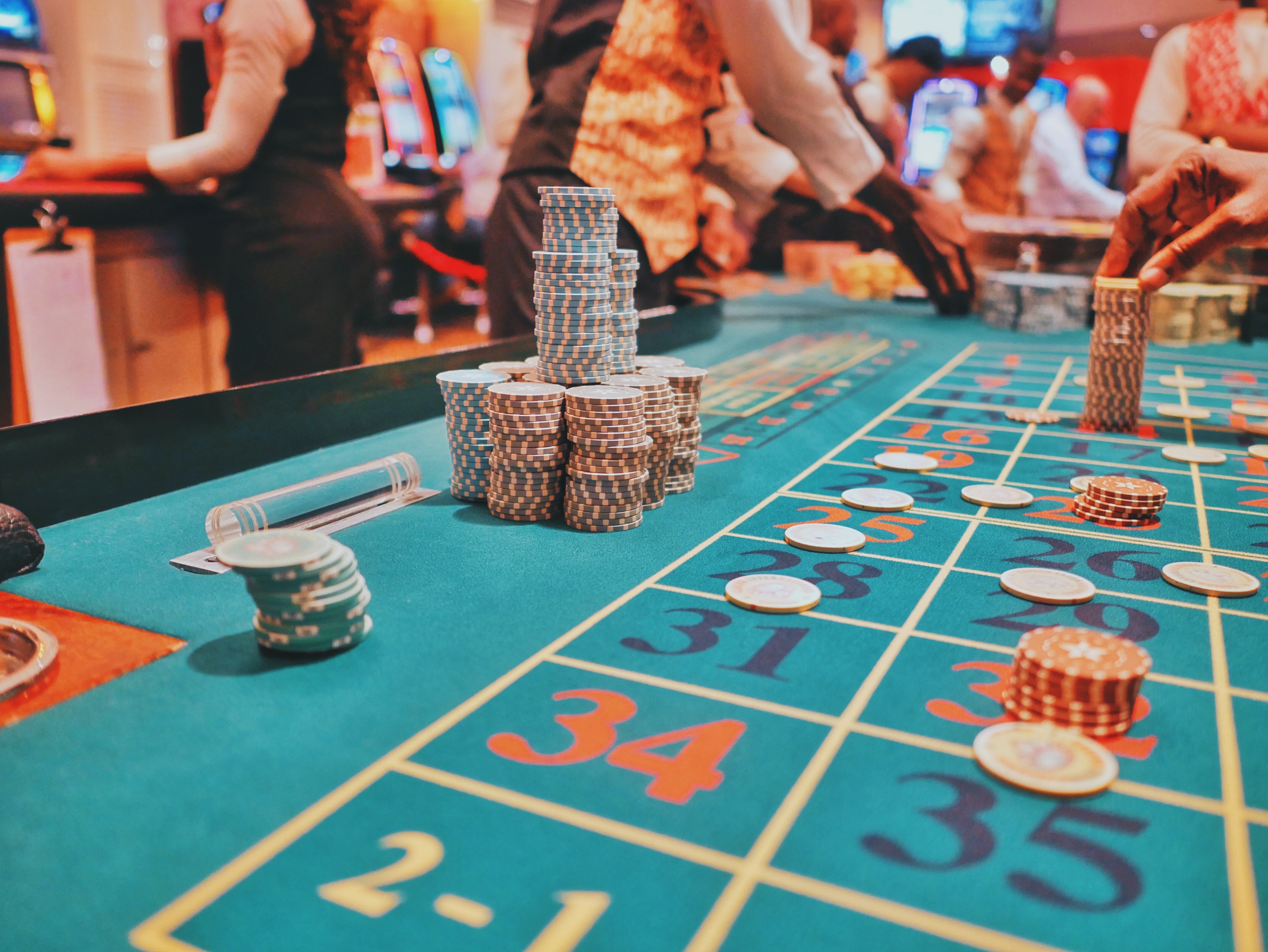
The W2G is the freewheeling cousin of the W-2. While a W-2 is for money you make while working, the W-2G is what you get while playing. If you win more than $600 in any gambling session at a casino – whoohoo! – the “house” should request your Tax ID (generally your Social Security number) and either prepare a W-2G on the spot or send it to you in January.
Casinos aren’t interested in keeping up with your losses, just your winnings, so they only tell the IRS about what they paid you. If you do go gambling and want to deduct losses, the IRS requires you to be able to provide receipts, tickets, statements or other records that show the amount of both your winnings and losses.
(And yeah, all of 2020 did seem like a gamble. You’re right.)
1099s (Income)
A 1099 is a form that basically says, “Hey, we paid you some money for something, but you weren’t an employee.” You get a copy; the IRS gets a copy. Easy-peasy.

There’s not just one type of 1099; actually, there are a whole bunch of 1099s. Some of the more common are:
Got a bank account? This form reflects the interest income you receive from interest-bearing savings and checking accounts, money market bank accounts, certificates of deposit, and other accounts that pay interest. It also notes whether foreign or U.S. taxes were withheld and if there were any penalties assigned for early withdrawal from an interest-bearing account. Internet-only banks often require you to log into your account to get your 1099-INT, so don’t count on it coming by mail. If you received less than $10 in interest, your bank may not send a 1099-INT.
Do you own stock or other taxable investments? This form indicates the dividends or capital gains you received as an investor. Your broker, plan services company, mutual fund company or other type of investment company will send this form. Not all dividends are created equal; ask your tax professional if you have any that seem unusual or complicated. Whether you receive dividend checks or your dividends are held in a DRIP (a direct re-investment plan), if you did not earn at least $10 in dividends, you are unlikely to receive a 1099-DIV.
This form is subtitled “Certain Government Payments” and can cover everything from state unemployment compensation to tax refunds, credits, and offsets at the state and local level. It can also be used to report payment of taxable grants, agricultural payments, and other nifty things where a state or local government gives you money.
1099-NEC (NEW!!!)
As noted above, this is a new form designed to take some of the weight off the 1099-MISC (see below). If you’re self-employed (a freelancer, an independent contractor, etc.), you should get a 1099-NEC, starting this year. However, people are unfamiliar with this form and may still send you 1099-MISC until the 1099-NEC is more widely known.
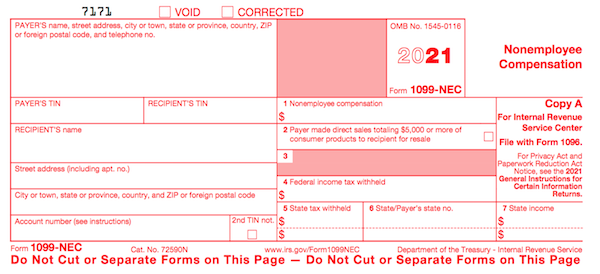
Another problem is that even if someone paid you for doing work as an independent contractor, they may not know they should be sending you a 1099-NEC. So, if you are self-employed or irregularly employed, it’s essential to keep track of your own incoming revenue. Otherwise, if the person who paid you ever gets audited, it could trigger some messy situations for you, too.
Now that this form no longer covers all the different forms of income for freelances and independent contractors, it is truly more applicable to call it “miscellaneous.” It will generally be used to report payment of royalties, broker payments, certain rents, prizes and awards, fishing boat proceeds (yes, really!), crop insurance proceeds, and some payments to attorneys that wouldn’t be reported on a 1099-NEC, like if you received a settlement and were required to pay an attorney a portion of it. In general, once people get used to the 1099-NEC, you’ll only get this miscellaneous form to report truly miscellaneous payments.
SSA-1099 (Nobody knows why the numbers and letters are reversed on this one form! It must be done by the same people who label the copies of W2s and bra sizes!)
If you receive Social Security benefits, you should receive an SSA-1099 or an SSA-1042s, the latter being for non-citizens who live outside the United States but receive benefits. (For example, widows or widowers who are receiving spousal benefits.) The 1099-SSA tends to come on a long form, folded and sealed such that it makes its own envelope.
A 1099 doesn’t always indicate that you were literally paid money. For example, a 1099-C indicates that a party has forgiven a debt, like a mortgage or part of a credit card balance. You may owe tax on forgiven debts, and the 1099-C alerts the IRS that since you didn’t pay money owed, and got to keep it in your pocket, it’s as if you received money.
Your 1099s sometimes hide in plain sight. Occasionally, instead of sending a 1099 in a separate envelope, a bank or brokerage house may include a 1099 form in the same envelope – sometimes perforated, at the bottom of a quarterly or end-of-year financial statement, so be sure to check all that boring-looking official mail that arrives. Multiple forms may be sent as a “combined 1099,” scrolling across multiple pages, so check the reverse of other forms, in case you seem to be missing one.
MONEY YOU PAID
1098 (Mortgage Interest)
A 1098 is not a 1099 with low-self-esteem. The vanilla, no-frills 1098 reflects the interest you paid on your mortgage, which is generally deductible on your federal taxes. Renters don’t get 1098s; neither do homeowners who’ve paid off their mortgages.
There are also sub-types of 1098s for things other than interest on property loans:
- 1098-T indicates tuition you paid; you’ll get this from a college or training school.
- 1098-E shows you’ve paid interest on a student loan and will come from your lender.
- 1098-C indicates the donation value of a car, boat or airplane.

Photo by Diego F. Parra from Pexels
1095-A (Health Insurance Statement)
The 1095-A is also called the Health Insurance Marketplace Statement. We are all generally required to have health insurance. If you purchased yours through a state or federal exchange, this document helps you determine whether you are able to receive an additional premium tax credit or have to pay some back.
Related forms include the 1095-B (supplied by companies with fewer than 50 employees), detailing the the type of coverage you had, the period of coverage, and your number of dependents, so you can prove you had the Minimum Essential Coverage (MEC) required by law. A 1095-C is similar, but for employers with more than 50 employees.
FINAL THOUGHTS
While I spelled out the most common ones, there are other, less common, information returns. If you receive a mysterious form, or have questions about how to use a form, the IRS has a surprisingly easy Forms, Instructions and Publications Search. Also, I am a Certified Professional Organizer, not an accountant, so please address any concerns to your friendly neighborhood tax preparer.
Making sure you have all of the necessary forms in hand will make it much easier to prepare your tax return. Once you have filed your taxes, make a list of all the forms you received this year, and tuck that list into your tickler file for next January. Check off each form as it arrives, and you’ll have a better sense of when you’ll be ready to start working on your 2021 taxes in 2022.
The Perfect Unfolding As We Work From Home
 Readers, I beg your indulgence as I wax philosophical today about folding and unfolding as we work from home. (No, this isn’t about laundry. I’ve written about that before, in 5 “Real Simple” Reasons We Don’t Get the Laundry (or Paperwork) Done.)
Readers, I beg your indulgence as I wax philosophical today about folding and unfolding as we work from home. (No, this isn’t about laundry. I’ve written about that before, in 5 “Real Simple” Reasons We Don’t Get the Laundry (or Paperwork) Done.)
This weekend was my birthday. Last year, I went out to dinner with a friend, and I remember that strange week, as everything was changing, but nobody knew what was to come. We tensely folded ourselves in toward the booth, away from our fellow diners. We were already being more circumspect, but it wasn’t until the next day or so before the reality of 2020 set in. (But this post isn’t really about that, either.)
The Folding and the Unfolding of the Lost Year
Over the past year, I’ve been thinking deeply about folding and unfolding as it relates to our lives now, both at home and at work. In most ways, our lives constricted 12 months ago. We were running around, blissfully living our lives, commuting to work, dining in restaurants, out there in the world. And then, almost overnight, we folded ourselves up, kit-and-caboodle, and took ourselves home. Crumpled into tinier lives in smaller spaces (at least smaller than the whole world we had at our disposal before), anxiety squished us into smaller versions of ourselves.
We’d packed up our work bags, our school bags, our schedules, and folded ourselves away in our houses, nervously watching newscasts and doomscrolling our devices as we perched on the edges of our couches and dining tables.
And then something interesting happened, though we couldn’t see it at first. We unfolded ourselves. We embraced freedom from sitting in one stuffy workspace, at one desk, between the same two co-workers. We unfolded the squished toes that had been crammed into the shoes we wore as part of our uniform to be taken seriously at work. We unpacked our projects and spread them out in the new spaces we had to create to work at home while avoiding feeling like we were living at work. (More on that in a bit.)
The Unfolding of New Opportunities
As some parts of our lives fell by the wayside, other new adventures eventually appeared.
I am proud to announce that I recently became Meori‘s first guest blogger. You might recall that I first wrote about Meori three years ago, in NAPO2018: Paper Doll Explores Meori & the Glorious Goodies Within.
When I was first contacted about being a guest blogger, I was enthusiastic but cautious, as I always am in these situations. As a Certified Professional Organizer®, I’ve built my practice on developing strategies to guide clients in creating systems for making their lives more organized and productive. I view organizing products as tools, always worthy of consideration, and I tell clients (and you readers) about how those tools can serve their needs. (And yes, I tell you about my favorite products.)
But I’m not a salesperson, and if they’d wanted someone to be a product spokesperson, I wouldn’t be anyone’s first choice. (I think we can agree that brevity is not the soul of my wit, and “pithy” is not in my wheelhouse.)
So, I was delighted when I first spoke with Deirdre Meyer, co-owner of Meori (with her husband Dirk) and Karen Oboy, Meori’s sales and marketing manager, about this opportunity. Deirdre made it clear that she wanted bloggers who knew about the necessary skills and systems of organizing.
And better yet, she wanted me to write a LONG post. (Readers? Can you imagine how hard it was for me not to jump through the Zoom window and hug them in their Seattle offices?)
In my premiere post, Home Office Storage Ideas: From Dad’s Office to the Modern Home Office, the great people of Meori gave me free reign to cover both the strategies (mindsets and systems) behind creating a peaceful, productivity-producing home office space and tactics (tools and methods) for making it all work. I encourage you to read the post at Meori’s site and let us know what ideas resonated with you. 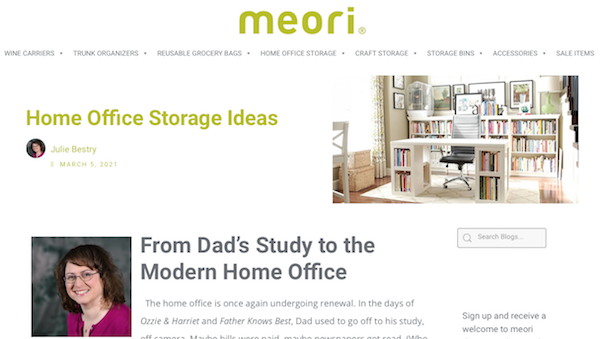
Unfolding and Folding Products
Initially, I was intrigued by Meori’s growing line of fold-flat storage products for home and office, but I was puzzled by their name, as I’d seen that the labels on the packaging were in English and German, and Meori didn’t strike me as a German word. It turns out, they combined two Japanese words, “meian” for great idea and “origami,” to create meori as “the fantastic idea of folding.”
I got excited, because I like things that fold and unfold, or collapse and recreate themselves. I’ve written before about how much I love Origami Rack shelves, desks, and racks, which “unfold” much like one opens an accordion or an ironing board. From flat-pack to fully useful in a minute!
Long before the pandemic, I was singing the praises of my Origami 6-Tier bookshelf, shown in operation above.
(I’m not an affiliate for either Meori or Origami Rack, but it occurs to me that, like Reese’s Peanut Butter Cups, these would be two great tastes that taste great together!)
Time To Unfold Again
We all eventually found our temporary footing, dealing with each ad hoc bump in the road that was 2020-2021. But lately, as the one-year mark approached, I’ve heard more complaints. Sitting on Zoom calls, I’ve noticed more and more people looking tense, almost as though they’d folded themselves directly into those tiny Zoom boxes. People are rolling their shoulders, trying to get rid of cricks in their necks. They’re fidgeting. They’re hitting the pandemic wall. They’re experiencing burnout.
Does that sound like someone you know (or someone you became) in the past year? It wouldn’t be surprising if it did, because a study by the CDC’s National Center for Health Statistics shows that 41% of Americans were showing signs of clinical depression or anxiety disorders at the start of this calendar year, up from 34% last spring. As I’ve written many times in the past year, we need to give ourselves some grace.
There have been multiple articles about hitting the pandemic wall:
It’s Not Just You: A Lot of Us Are Hitting the Pandemic Wall (Huffington Post)
Why Kids Are Hitting the Pandemic Wall (CNN)
America Has Hit the Pandemic Wall (The Washington Post)
This article from Mayo Clinic, Job Burnout: How to Spot it and Take Action, was created in the “before times” but it’s just as apt now. They define burnout as, “…a special type of work-related stress — a state of physical or emotional exhaustion that also involves a sense of reduced accomplishment and loss of personal identity.” Those symptoms sure sound familiar to my friends and clients.
Personally, after hitting a snag back in April, 2020, I felt like I was handling everything fairly well. After all, I’d been “working from home” (for administrivia) for most of twenty years, though it only make sense to organize at clients’ homes and offices, because that’s where the clutter lives!
“You are not working from home; you are at your home during a crisis trying to work.” pic.twitter.com/nsfb2ecTZZ
— Ethics in Bricks (@EthicsInBricks) January 2, 2021
But, as wise tweets reminded us, we weren’t just working from home. We were working from home during a crisis. I thought I’d handled the complexities of virtual organizing and “working from home” well until January, and then all bets were off. Focusing got harder; I blew through a soft deadline and had to explain to the nice Meori people that yes, I’d hit the pandemic wall, too.
Unfolding & Untangling Your Work Self and Your Self Self
It’s been my contention for a while that the biggest problem we experienced, just after we got a hang of working from home, is that we made our work lives so comfortable that we were now living at work.
One good thing about our old lives was that, for most people (who weren’t already working from home), it was easy to fold oneself up to fit in a work space and a home space. Before the pandemic, people who went off to work didn’t need the same kind of help as work-from-homers, such as I’d presented in R-E-S-P-E-C-T: The Organizing Secret for Working at Home back in 2015.
That post focused on how to show respect to yourself, and how to get others to respect the value of your time, when you’re working from home. Nowadays, that advice is more needed that ever.

Photo by rishikesh yogpeeth on Unsplash
If you’re feeling all-folded-up, maybe even tangled up, I encourage you to start with the following:
1) Separate your work space from your home space.
I know, that sounds ridiculous. You probably don’t have oodles of space You finally found the “good” lighting so you don’t mind having your Zoom camera turned on, so I’m not going to tell you to create two spaces, one for Zooming for work and one for Zoom-hanging with your friends. (But if you do have the space, your friends will love you just as much if you move the laptop or tablet to the couch, and look more like if they were on the couch with you, in an imperfectly-lit room, and less like you’re about to advance a Powerpoint slide at any moment.)
Basically, it’s been a year, and you’ve probably got a work space that works for you. (If not, that’s even more reason to check out my Meori guest post!) But maybe it’s time to create more space at home in which to live.
As the weather warms up, maybe move a chair onto your front porch and read 10 pages of a novel in the fresh air and daylight during your lunch break? Maybe make sure you’re not eating at your desk, even if your desk is your dining table?
2) Understand that downtime is good for you – and your career.
Usually, my advice is designed to make your work life more productive. For years, in the “before times,” I told clients to treat working from home as if they were working from an office. Run laundry or make personal calls at lunchtime, if you must, I’d say, but work when you are “at work” and do home things on your “personal” time.
Wow, how very 2019 of me!
This advice made sense when the struggle was ignoring inanimate sensory inputs (a pile of laundry, bills to be paid, dinner to defrost); now, the sensory inputs are tiny humans needing help, or a gentle prodding, with online school. You can’t, and shouldn’t, be all-work-and-no-play during the day.
According to research by the National Bureau of Economic Research, Zooming is helping us keep our meetings shorter, but we’re working longer. “We also find significant and durable increases in length of the average workday (+8.2 percent, or +48.5 minutes), along with short-term increases in email activity,” they found.
As the articles on hitting the pandemic wall acknowledge, we’re all experiencing overstimulation. We’re ALWAYS ON, so of course it’s hard to wind down. Just as the temptation to address home things during work hours must be guarded against, we struggle with doing more work during “home” time.
So, maybe don’t check work email while you wait for the pasta to boil. Pick up a book from your to-be-read pile instead of a report from work. Turn off your Slack notifications at night and on the weekend.
Embrace the idea that you are more than just your job. Perhaps read this New York Times article, Remember: What You Do Is Not Who You Are. A snippet I particularly liked, in (and following) an interview with Art Markman, a professor of psychology and marketing at the University of Texas at Austin, said:
“The brain needs a little downtime,” he said. “You can’t sustain concentration. Unless you can get away from the problems you’re trying to solve in your work life, you don’t give your brain a chance to reset and come up with a different way of characterizing what you’re dealing with. So even if your primary goal in life is to be as productive as possible at work, you need some time away to make that happen.”
This doesn’t mean you shouldn’t be invested in your work or not care about your career and the people you work with. That investment can be an asset, and being passionate about one’s work can help lead to better output. Rather, give that investment a ceiling.
3) Put the commute back into your day.
Inc. Magazine recently ran an article called The German Secret to Getting More Done While Working Remotely. Even though my job is to help people be more productive, inwardly, I groaned when I read the headline. Isn’t everyone already feeling guilty and dismayed by not getting more done, as if the purpose of life was to be more productive? (Paper Doll has a secret for you. I think the purpose of life is to ENJOY YOUR LIFE. Be productive so you can have more time to do that!)
Paper Doll has a secret for you. I think the purpose of life is to ENJOY YOUR LIFE. Be productive so you can have more time to do THAT! Share on XWhat did you do on your morning commute? Did you listen to a podcast? Talk to the people who sat by you on the train? Read? Maybe your “commute” was just driving your kids to school before turning around and heading home for the rest of your day. Are you missing those things? Your afternoon commute has similarly been blown out of the water.
For years, I’d recommended to clients who had trouble starting their work days to put on their shoes, even their coats, and go outside and then come back in before sitting down to work. Whether they went to a coffee house to procure overpriced coffee, walked around the block, or just went out the garage door and came back in the front door, this helped them trigger their brains that it was time to start the work day. Whether it’s our morning commute or our kids hearing the announcements over the PA at school (they DO still do that, right?), we need rituals to start our days.
Well, this fancy-pants Harvard professor – OK, I’ll be fair, it’s possible he has perfectly quotidian pants – advises much the same, though he focuses on the end of the workday. Per Professor Ashley Willhans, the Germans have a concept called feierabend. Google Translate merely says it’s “the end of the working day,” but apparent it’s more of “a daily evening celebration marking the moment when work is switched off for the day.” (And it apparently involves beer.)
In the old days, people sometimes went from work to the gym, and then home. So maybe this means our date with Yoga With Adriene needs to come at the end of our work day, and maybe that needs to be a bit earlier? Perhaps knowing that we can’t push dinner too terribly late (either for the comfort of our family or of our digestion) means that we’ll have to truly stop work so we can change from our work loungewear into our workout loungewear and work out at a decent hour so we can eat at a decent time?
My own end-of-day ritual is calling Paper Mommy. The idea of debriefing, recapping my work day, out loud (often during a 45-minute walk outside) is just what I need to unknot, detangle, and unfold my brain, my body, and my life. What kind of “commute” could you add to the start and end of your day?
Unfolding of Hope and Confidence
In the past year, my friend and colleague, Dr. Melissa Gratias, introduced me to the concept of the Shraddha Sutra she learned in her meditation class. (You can read Melissa’s take on it in her post, Are We Broken?)
śraddhā = śrad + dhāśrad literally means “that which gives you space and holds you in place” dhā provides nourishment for you to grow śraddhā conviction; faith; trust
However, my friend’s meditation teacher explained it more conceptually as “radical trust in the perfect unfolding” of one’s life.
Whoa.
Melissa and I have been discussing this concept a lot over the last year, as we look at how our spaces, our careers, our relationships, and our very lives have been evolving. I said it in my post, The Now Normal: When the New Normal Changes Quickly, and I have been surprised by how prophetic it was. (Whoohoo, Paper Doll!)
This March is not last March. We see sunlight instead of darkness. Every day, more of our parents and grandparents and friends are able to get the vaccine. More of us have a sense of what we want our lives to be (or not be) as we come out on the other side, as we unfold ourselves into new shapes and new selves.
Perhaps this probably didn’t sound very much like an organizing and productivity post. But please remember that the purpose of organizing, at least the Paper Doll version of it, is to have more space and time to do the things you want with the people you care about.
So, I don’t know about the radical trust part, but as we move forward, I hope that you experience the perfect unfolding of your life.
Flow and Faux (Accountability): Productivity, Focus, and Alex Trebek

Image by Engin Akyurt from Pixabay
Last week, in Count on Accountability: 5 Productivity Support Solutions, I presented five methods for getting accountability:
- accountability partners, like friends, colleagues, or people you can meet through apps like Supporti or Focusmate
- accountability groups, like mastermind groups, in-person study groups, virtual study groups like Hours, and professional groups
- professionals, including professional organizers, life coaches, and fitness trainers
- apps and gadgets, including StickK, Beeminder, the saucily-named (and partially redacted) Go F***ing Do It, and Pavlok
- events, whether DIYed, sponsored by a specific entity (like Deb Lee’s periodic Action Days), or “work gyms” like Caveday or Ultraworking
Across the various social networks, this post garnered quite a bit of conversation about what accountability methods worked for different people and for different activities.
Then, from Thursday through Saturday, I participated in the Task Management & Time Blocking Virtual Summit 2021, with so many of my all-star colleagues from NAPO and the productivity world, as well as big names and some surprising up-and-comers. (In an forthcoming post, you’ll be hearing about a group of talented young people surpassing all expectations in developing a task management solution. Spoilers!)
At the summit, during the online networking, a conversation among attendees sprung up regarding an accountability concern I hadn’t considered. While some mentioned that they were introverts, even the extroverts shared similar thoughts: they were intrigued by the accountability options I’d mentioned, but at least sometimes, they didn’t want to deal with other people!
WE’RE ZOOM-WEARY
I suspect the pandemic has simultaneously made us wary of other humans and weary of digital communication. After all, Zoom Fatigue (and Meet Fatigue, and Facetime Fatigue) is real:
Four Causes of Zoom Fatigue and Their Solutions (Stanford University)
Zoom Fatigue Isn’t Just a Buzzy Term: 4 Common Causes and Fixes (MindBodyGreen)
Four Reasons You’re Tired of Zoom Calls and What To Do About It (Washington Post)
Zoom Fatigue Cartoon (Marketoonist)
Zoom-weary lawyer via GIPHY
To all the common causes mentioned, I’ll add that our voices and our lungs are doing unrealized extra effort. When you’re in a conference room or office with someone, you have a sense of the room’s acoustics; you know when you’re being too loud or too quiet, and other people’s reactions will alert you to that fact. (Fear you’re too loud on your phone at your desk? Look around the room – if people are looking at you and then their eyes dart away, then shush! We don’t treat overheard conversations like radio, but like TV, and turn toward it.) On the phone, we also have a sense of how to modulate our voices properly.
But virtually? With people using computer microphones, ear buds, headsets, Bluetooth podcasting mics, and more, volume varies. We’re all self-conscious, uncertain about how we sound. When we get excited, we lift our voices (and may breathe heavier and more deeply) because the chasm between ourselves and the faces on the “black mirrors” in front of us make us feel like we’re shouting across miles.
“But Paper Doll,” you ask, “what does Zoom Fatigue have to do with productivity?”
ACCOUNTABILITY’S DISTRACTIBILITY PROBLEM
Right. Yes. Back at the virtual summit, what these people really liked about the idea of accountability events was feeling like they were working among others. But even though they wanted that feeling of being back in the office again, having some camaraderie, they were vocal about what they did NOT want:
- to feel observed while they were working
- to feel the need to be social (even though accountability events, work gyms, and even virtual co-working partnerships are supposed to limit the chitchat)
- to have to do their hair or makeup or put on semi-grownup clothes
- to feel judged
- to be distracted by the other people’s homes or offices, better hair, or virtual backgrounds (One woman said that if she ended up with a virtual accountability partner who was too attractive, she’d be too self-conscious to focus, recalling memories of 10th grade study hall.)
My response in these conversations developed over a few days. At first, I joked that maybe setting up children’s stuffed animals across the table, as if for a tea party, might approximate the body doubling phenomenon we discussed last week.
But then I realized that the problem with that solution (even once you get past the suspension of disbelief) is that there’s no apparent feeling of humanity. Body doubling and most actual accountability methods involve at least some minimal interaction, even if it’s just a virtual handshake preceding getting down to business.
But maybe it doesn’t always have to be the ability to SEE someone doing something. Maybe hearing somebody doing something might be enough to help us focus and concentrate?
SIDEBAR ON FLOW AND THE UNPRONOUNCEABLE MIHALY CSIKSZENTMIHALYI
You’ve probably heard about flow, a state of concentration or complete absorption with the activity at hand and the situation. You know – when you’re in the zone. The concept was popularized by Mihaly Csikszentmihalyi, in his book Flow: The Psychology of Optimal Experience.
The key idea of flow underpins everything we attempt in the productivity realm, from Cal Newport’s “deep work” to our Pomodoro Technique efforts. When we’re distracted by our own thoughts and worries, or the neighbor’s leaf blower, or an office-mate who chews his gum with his mouth open, it’s hard to get into flow. However, flow is what we need most. Hear about in the man’s own words:
If you had any trouble getting into flow with that talk, check out Fight Mediocrity’s animated book review of Flow and PositivePsychology.com’s deep dive into 8 Ways to Create Flow According to Mihaly Csikszentmihalyi.
Oh, and that unpronounceable name? If you can say this: “Me? Hi! Chick sent me. Hi!” then you can say his name. (You’re welcome.)
FAUX ACCOUNTABILITY FOR FLOW
So, if seeing other people in an unnatural co-working or accountability setting will be distracting, what about only hearing other people? And in particular, hearing them but having them not being able to hear you? And NOT having the kind of distractibility that comes from unintentional eavesdropping?

These summit discussions kept reminding me of my blog post, 11 Ways To Organize Your Focus With Ambient Noise. After six and a half years, this has proven to be one of my most popular posts. People really embraced the ideas of white (and brown, and pink) noise, and how soothing sounds enable you to get into flow.
Most of the neuroscience-approved solutions I provided were either nature sounds, like babbling brooks, rain, wind, etc., or similarly non-human sounds, like crackling fireplaces, showers, or washing machines. But a few of my suggestions had included background sounds that were not found in nature, but in the public realm, and in the past year, as people have missed going to coffee houses, bars, and yes, even the office, auditory “virtual happy places” have grown in popularity.
This is why I call it “faux” accountability. There’s none of that key accountability where you tell someone else what you need to work on and honor that externalized obligation to yourself; this is more like the general sense that when you’ve taken your work to a coffee shop, you’re counting on generating that flow state, getting yourself into the zone, and working. Out in the real world (of yore), you counted on a more implied sense of accountability.
You don’t tell the barista or the guy at the next table that you’re a serious person doing serious work writing a serious blog. But you buy your coffee to get the WiFi code, you sit at the table nearest the outlet so you can keep your laptop charged, and you get to work knowing that all those strangers (who really aren’t thinking about you at all, unless you’re hogging the outlet) are expecting you to GET. STUFF. DONE!
So, I posit, what if you could get that same feeling virtually?
Coffitivity
Coffitivity was the first browser-based site of its kind to hit the mainstream. Based on research by Ravi Mehta, Rui (Juliet) Zhu and Amar Cheema in Is Noise Always Bad? Exploring the Effects of Ambient Noise on Creative Cognition, and published in the Journal of Consumer Research, Coffitivity took the idea that “a moderate level of ambient noise is conducive to creative cognition” and ran with it. There are three free soundtracks in the cafe library:
- Morning Murmur – “a gentle hum gets the day going”
- Lunchtime Lounge – “busting chatter of the lunchtime rush”
- University Undertones – “the scholarly sounds of a campus cafe”
For $9/month, you can upgrade to premium level and access:
- Paris Paradise – “energizing ambiance from the City of Light”
- Brazil Bistro – “the musical chatter of a Brazilian coffeehouse”
- Texas Teahouse – “hefty sounds from a big state”
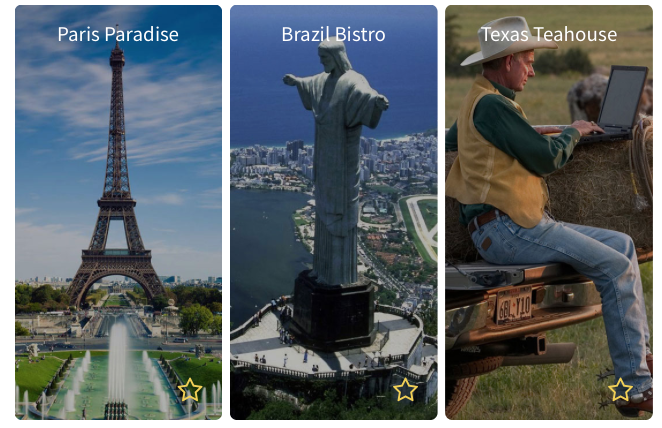
Coffitivity also has a friendly blog written with cognitive, financial, and social needs of freelancers, solopreneurs, and remote workers in mind.
Although Coffitivity is browser-based, there’s a MacOS desktop app if you want to run it when you’re offline.
HipsterSound
HipsterSound’s Cafe Vibes has three public audio tracks: the buzz of a busy Texas cafe, Les Charmants Cafés de Paris, and the gentle hum of a quiet restaurant. In addition, at the premium level, there’s the gentle chatter of a Danish restaurant, the bustling vibe of a Rio de Janiero restaurant, the animated buzz of a cafeteria, a lively library ambiance, and an advanced rain simulator.
In addition, you can toggle on/off a variety of other sounds, including a desk fan, a co-worker’s typing, nature sounds, and different venue noises (a jazz club, an open-air bistro) and listen to any combination of those sounds on their own OR combined with the cafe and restaurant audio tracks.

Because I didn’t pony up the $2/month (though you can pay less if you get a one-year subscription), I couldn’t listen in on the foreign language options. In general, though, none of the voices on these kinds of apps can be discerned enough to be distracting. After a year of lockdown, it might be a relief to do your work in Copenhagen or Rio!
Use HipsterSounds in your browser or via the Android app.
Cafe Restaurant, Calm Office and myNoise Development
Cafe Restaurant, from myNoise, which I included in my original post about ambient noise, looks much the same but has expanded its offerings. It still lets you use the sliders to adjust audio element styles that include the “levels” of Rumble, Restaurant, Chatter, two separate levels for Babble, Mess, Cafeteria, Cafe, Table, and Kitchen. You can now increase or decrease the speed of the soundtracks, and they’ve added both a meditation bell and a timer, useful for those who wish to implement the Pomodoro Technique.
One of the newer sibling ambient soundtracks that might be perfect for remote workers looking to simulate that soothing office hum is Calm Office.

The adjustable sliders in this app include room tone, air conditioning (which, like in a real office, seems to lean toward the overpowering, (unintelligible) chatty colleagues, copy machine, printer and scanner, blended generic office noises, keyboard and mouse clicks, pen on paper, and a loudly ticking “office clock” noise.
myNoise has added a number of other related ambient environments you might want to add to your productivity arsenal:
- Catholic Church – adjustable levels are available for rain and thunder, two kinds of bells, an organ, two kinds of whispers, footsteps, random people noises, and the hushed voice of a priest. In college, I would sometimes do homework in the vestibule of a church while my friend attended Saturday evening Mass, and I can attest to the fact that (for this Jewish girl, at least), it made for a very calming background noise. I can imagine, however, that many other religious services might have a bit too much energetic verve to (sacrilegiously?) use as background noise.
- Mexico City – as part of a developing series of global cities, this option includes busy streets and traffic noises, the Mercado Coyoacan (market), mariachis, trompetistas, protests and police sirens, and birds. While it seems like it would be hard to get into flow with this atmosphere, to each one’s own.
- Night Commute – for those who miss the creative inspiration or flow state of their nightly drive or ride, this option does not offer up traffic noises, subway doors closing, or anything similar. Rather, it’s a mix of jazzy music that reminds me more of a movie montage of a commute than an actual commute.
The myNoise mixable soundtracks are available for the browser and in an iOS app; there’s an Android version, as well, but in the past seven years, myNoise has remained dissatisfied with ongoing Android problems and recommends Android users listen via mobile browsers.
Magical Tearoom
For something really simple, look no further than the Magical Tearoom. There are no pre-sets, no toggles, no sliders. There are no options at all. It’s just an eight-hour YouTube video with the cozy sounds of an old-fashioned tearoom, paired with a vaguely Eastern setting. The hot water periodically gets replenished, the tea leaves float, the steam rises, and other satisfied visitors burble unintelligibly, creating a calming, peaceful space for focusing on your work.
While one is left to assume that the “magic” comes from the sparkly bits flecked across the screen like so much pixie dust, I’ve found something else. In general, I need my white/pink/brown noise to be devoid of human sounds, so what’s magical to me here is that the atmosphere feels the most natural and the easiest to settle into. I’ve written much of this post “in” the Magical Tearoom.
I’d encourage you to check out the many other sound collections from this creator, Miracle Forest. Those tend to be shorter, about two hours in length (suitable for four Pomodoros, with breaks), and have themes, like a Hogwarts-inspired rainy Castle Reading Nook or Study Session at Night.
Sounds of Colleagues
Sounds of Colleagues is the result of a creative collaboration between Familjen STHLM, a Swedish advertising agency, and Red Pipe Studios, an audio branding agency. When Sweden locked down and offices closed, employees at both really missed their peeps, giving rise to this simple page.

Use the sliders to raise or lower the levels of sounds of the general room tone, the coffee machine (likely nicer than what you had in your office), co-workers, printer, rain on the window, keyboards, sounds outside the open office window (including car horns and traffic). There’s also an alternatingly barky and whimpering office dog (and an occasional, whispered “good boy!”) and a ringing telephone. I urge you to turn the telephone sound down all the way, as the virtual phone is as annoyingly distracting as it is in real life.
If you miss your office, and maybe even the people in it, this is the most pleasantly realistic. For deep work, I suggest using the browser version works as I’ve described. However, if you prefer variety, on Spotify, you can listen to a playlist of short 2-5 minute tracks, with titles like “Corporate Office in the Middle of the City,” “90s Office With Landlines Ringing” (don’t – just don’t), and “Cocktails and Typewriters Anno 1960.” (There’s that Mad Men theme again!)
I Miss My Bar
Maybe you’re more of a Hemingway (“Write drunk. Edit sober.”) person, and you’d get more flow and accountability and less distraction in a bar than a coffee house or office?
Maybe you're more of a Hemingway ('Write drunk. Edit sober.') person, and you'd get more flow and accountability and less distraction in a bar than a coffee house or office? Share on XViral sensation I Miss My Bar has you covered. Maverick, a jazzy bar/restaurant in Monterrey, Mexico, had to close during the pandemic, but created this platform, leaving the following message:
We all miss our bar.
Hanging out with friends, deep conversations over Gin & Tonics, meeting great new people, the atmosphere.
Even though these things will never be replaced, at Maverick we’ve made this modern digital artifact to keep you company while this awful pandemic, which profoundly affects our industry throughout the world, finally passes and we can meet again safely.
Plug your device to a decent speaker set and use it as a background sound for your zoom parties, or just for your daily wind down cocktail at home.
As every hospitality professional in the world we, too, miss you as well. If you are feeling generous, try to find a way to support your favourite local bar staff today. You can support ours here.

Get into your work groove while listening to the weekly music playlist; use the sliders to adjust the sounds of a bartender mixing drinks, a full-room crowd, rain on the window, night ambiance (in case you’re on the bar’s back deck), street noises, and drinks being served.
To get a sense of the Maverick bar’s actual ambience and menu, here’s a translated version of their website. I suspect, when the world tips back enough toward the old ways, Maverick will have a lot of real-world visitors.
AN ENCOURAGING WORD
If one of these “faux” accountability methods helps you achieve flow, hunker down, and do your best work, there’s still one aspect of the traditional accountability experience you might still feel like you’re missing: the “Atta Girl!” or “Atta Boy!” at the end of a work session. And for this, the late and much-loved Alex Trebek has provided for us all, via an homage page created by Rex Sorgatz.
Visit the Trebek Affirmation Page, click on any (or all) of the dollar values, and let the dulcet tones of the eternal host of Jeopardy! give you whatever positive external feedback you need.

Finally, much of this post was inspired by the experience at this past week’s Task Management & Time Blocking Virtual Summit 2021, which I told you about in the Playing With Blocks: Success Strategies for Time Blocking Productivity. While the summit is over, you can still enjoy the educational experience at your own convenience if you purchase an All Access Pass.
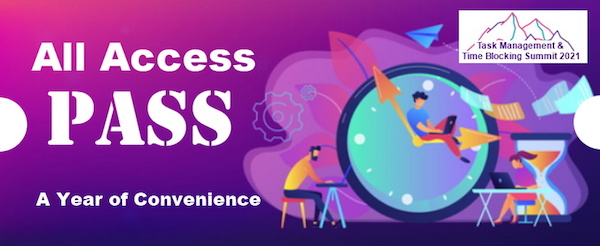
Count on Accountability: 5 Productivity Support Solutions

Procrastination strikes for many reasons: perfectionism, fear of failure, lack of inspiration. Sometimes, there’s no apparent reason why we procrastinate on completing a task or working on a project; we just know that do and we wish that we didn’t.
Canadian psychology professor and all-around expert on procrastination, Timothy Pychyl, author of Solving the Procrastination Puzzle: A Concise Guide to Strategies for Change, explains that procrastination isn’t just delay. He explains that procrastination is “a voluntary delay of an intended act,” one where the person procrastinating is cognizant that the delay is going to have a cost, whether that cost is financial, interpersonal, professional, legal, or otherwise.
When we procrastinate, we know that there’s no upside; we aren’t merely weighing a logical choice between two options of equal value. It’s less, “geez, how can I decide on whether to go on this romantic anniversary date with my spouse or prepare for my presentation this week?” and more, “Eek, I’m feeling icky about doing this thing for some reason and I’ll latch on to any random thing, like bingeing a sit-com I’ve seen in its entirety three times!”
Experts like Pychyl have found that at its base, procrastination is “an emotion regulation strategy” – a way to cope with a particular emotion while failing to self-regulate and perform a task we know we need to do. We convince ourselves we’d rather feel good now, thereby causing more trouble for our future selves.
And be assured, professional organizers and productivity experts are not immune. I’ll admit that I hit a Pandemic Productivity Wall in February on a project I could normally complete in my sleep, but every time I sat down to attempt it, I couldn’t focus and got anxious. We all know how this feels.
Today, we’re going to look at one particular well-researched strategy for outmaneuvering our procrastinating selves: accountability.
So, What Is Accountability?
At its most basic, accountability is having some external source hold your feet to the metaphorical fire. It can work in many ways.
As professional organizers, my colleagues and I often perform a technique popularized in the ADHD community called body doubling. We literally work side-by-side, often quietly folding clothes or sorting papers while clients sort through their possessions or pay their bills. When you’re on your own, you might find ways to delay or distract yourself, but when someone is there, investing their time in you (and you’re investing your time and money to achieve your goals), body doubling helps you push past the anxiety and be more productive.
Accountability can be a matter of having someone check in with you. Knowing that someone else is taking an active role in caring whether you get a task done (but who doesn’t directly benefit from you completing the task, so it doesn’t feel like nagging) can get you over the hump. It’s all about support.
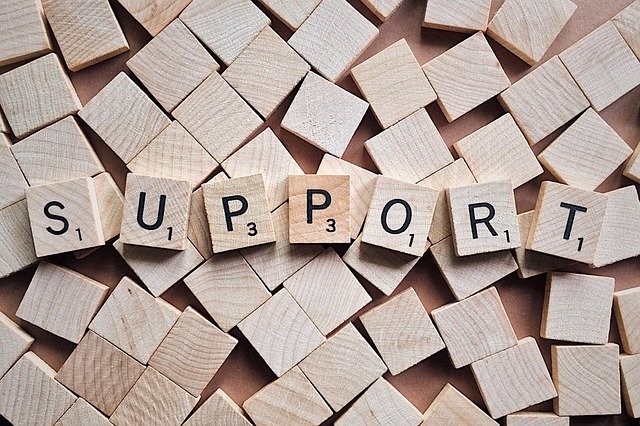
Image by Wokandapix from Pixabay
Accountability can be accomplished by dangling the carrot to give you an emotional reward, or threatening with the stick, yielding an unfortunate experience or event even worse than the result of your procrastination.
There are five main ways to get accountability. Not all will work for every person or in every situation, so it’s worth experimenting.
FIND AN ACCOUNTABILITY PARTNER
The first category for getting accountability support is to seek out one individual at no financial cost.
- A close friend or loved one – Getting support from someone close to you works best when the stakes are low and what you need most is a cheerleader. Let’s say that you’ve literally hit the wall in your closet – all the walls – and there’s just too much clothing in not enough space. Every time you attempt to start purging your closet, the prospect of trying things on and discarding much-loved clothes slows you down.
In the parlance of Grey’s Anatomy, call “your person,” the one you could call for anything.
Explain to your friend what you want to do. Agree to talk at the start, and set the alarm for a reasonable amount of time, perhaps 45 minutes. When the alarm goes off, you call or text her (or she calls or texts you, depending on what you’ve decided), and you can report in. If you had trouble deciding about a few items, you can have an ad hoc fashion show, or otherwise seek your friend’s advice.
You see, the sneaky thing about accountability is that many of us are bad at doing things for ourselves. But the minute we know that someone else cares whether we accomplish the task, even if they have no inherent skin in the game, we tend to push forward to accomplish it.
Note: this isn’t applicable to everyone. While many of would fall into Gretchen Rubin’s Obliger or Upholder categories, per her Four Tendencies of responding to expectations, there are a handful of rebels and Questioners out there who chafe at fulfilling others’ expectations. If that’s you, accountability may still work for you, but more because of the camaraderie than the idea of fulfilling implied obligations to someone else.
I’ve had a number of accountability buddies over the years, including professional organizer Jeri Dansky, with whom I used to trade daily accountability emails, and my long-time accountability partner, Dr. Melissa Gratias. I have a virtual meeting once a month with Melissa and her dog Dobby, where we review what we said what we would accomplish and set new goals. This isn’t for time-specific tasks, but more for having a partner-in-crime to keep focused on growing our businesses.
Not everyone feels comfortable asking a close friend or relative for this kind of support; sometimes we fear feeling too judged by the people we like the most. (True story: I once told PaperMommy, “I value your opinion too much to actually want to hear it!”)
Sometimes we fear feeling judged by the people we like the most. (True story: I once told @PaperMommy, 'I value your opinion too much to actually want to hear it!)' Share on XIf you’d still like to find just one accountability buddy, whether for an ad hoc task or perhaps for a longer term partnership, you may be more comfortable setting up an accountability relationship with someone you don’t know as well, like a colleague. That little bit of competitive friction may push you through your procrastination.
Other opportunities you might try:
- Put a post on social media and ask if anyone would like a short-term accountability partnership (for an hour, a day, a week…)
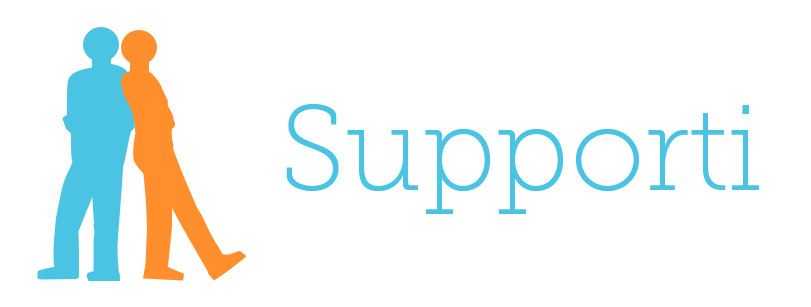
- Try an app like Supporti, which pairs you up with a one-on-one buddy for one week at a time.

- For your professional endeavors, consider Focusmate, a virtual co-working model where you “work by connecting to other professionals who have committed to being accountable for finishing their most important work.”
Focusmate claims that this style of virtual coworking “harnesses pillars of psychology proven to boost productivity 200-300%.” You set the time(s) you want to be productive, and Focusmate sends you an email to confirm your virtual session. (You need to use Chrome on your computer, or Chrome or Safari on mobile.)
At the appointed time, you greet your partner, declare your goal, and work for 50 minutes, quietly but in tandem, approximating the body doubling model. You get three focused sessions in a week for free. Read more about this platform in Mel Magazine‘s I Let A Stranger Watch Me Work For a Day — And I’ve Never Been More Productive. (As an added bonus, I was surprised and delighted to see that Melissa Gratias was interviewed!)
JOIN AN ACCOUNTABILITY GROUP
Support groups are popular for a reason. Whether you’re talking about a Twelve Step program, a lifestyle program like Weight Watchers, or school or professional groups, members support one another toward a like-minded goal. This is ideal when you’re not looking for someone to help you stick with a task, but progress toward a larger life achievement. Consider:
- Mastermind groups seem like a newfangled option, but they’ve actually been around for almost a century, when they were proposed by Napoleon Hill in his 1925 book The Law of Success, and explained in more detail in his 1937 book Think and Grow Rich. Basically, mastermind groups are peer-to-peer mentoring group; everyone’s a mentor, and everyone’s a protégée. Members present their professional concerns, brainstorm together, offer input…and provide accountability.
Golden Circle, the veteran members of NAPO, offered us the opportunity to form our own mastermind groups a few years ago. I’m delighted to be a member of the PM Crew (we meet in the evenings because Paper Doll is not a morning person), which includes my colleagues Maria White in Ashburn, VA, Nancy Haworth in Raleigh, NC, Yve Irish in Rochester, NY, and Karen Sprinkle (just up the highway from me) in Knoxville, TN. We meet once a month by phone or Zoom, send weekly group emails recapping our progress on the prior week’s goals and setting goals for the upcoming week, and share LOTS of supportive texts. Yve, in particular, is a star when it comes to sending supportive memes, gifs, and bitmojis:
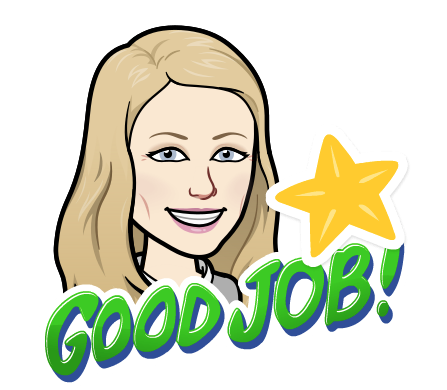
- Study groups have been around since at least ancient Greece. Law schools and MBA programs, in particular, promote the use of study groups: they study cases, debate approaches, and help one another maintain focus and keep pace. Whether you’re a freshman in college or taking Bible study classes, whatever you’re trying to learn, forming a study group can help you ensure that you’ll hit your goals and gain confidence in both the content and your own skills.
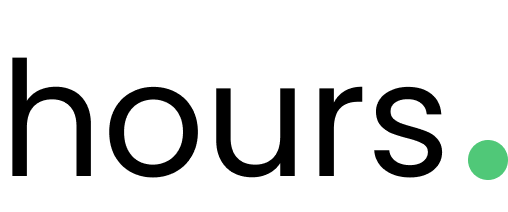
- Virtual study groups are a twist on working with your actual classmates. For example, Hours uses the concepts of gentle social pressure for accountability and the focused attention of having a pre-determined commitment to create a study/work partnership for improved productivity.
- Professionally led groups are another option. A number of professional organizers and productivity experts lead in-person and virtual membership groups to create a collaborative platform for helping members achieve their goals.
HIRE A PROFESSIONAL
As a Certified Professional Organizer, my colleagues and I are, in many ways, professional accountability partners. We provide physical organizing services and share our expertise on organizing and productivity topics, but clients often say that motivational and accountability support is the key to helping them break through the emotional obstacles to getting things done.
The type of accountability you get from a professional organizer might include in-person or virtual body doubling, homework assignments, or phone/email/virtual check-ins, and the type of accountability format will depend on your needs and personal style.
To find a professional organizer who can help you in-person or virtually, use the search functions at NAPO, the Institute for Challenging Disorganization, or Professional Organizers In Canada.
Other professionals you might consider to help you gain accountability might include a:
- business coach
- life coach
- ADD/ADHD coach
- fitness coach or personal trainer
- There are even people who bill themselves as accountability coaches. Although I was unfamiliar with the term, I was intrigued by this provider on Fiverr, who offers three levels of accountability coaching, with goal setting and check-in sessions.
To find a coach or specialist for your needs, you might wish to search the International Coaching Federation.
DOWNLOAD AN APP OR USE A GADGET
If you’re an introvert (or shy), you may prefer to get accountability without face-to-face (in-person or virtual) interaction. If that’s the case, a number of apps and digital solutions can provide accountability, but these are better for longer-term goals than specific tasks or short-term projects.

- StickK – This is an app-based commitment platform designed for those for whom the carrot (a reward) is less effective than the stick; in some circles, this is called loss aversion. Users sign “commitment contracts,” stating the amount of money they’re willing to put on the line to achieve their defined goals (for health, career, exercise, etc.). For example, if you don’t follow through, then the $250 you earmark will be given to a politician or charity you would never support. (If you achieve your goal, you get your money back and may earn some.) StickK’s stakes don’t have to be financial; they can be “reputational,” meaning you might have to publicly say or do something embarassing if you fail to achieve your goal. It’s not everyone’s cup of tea, but it is a bold option.
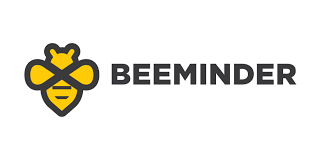
- Beeminder – The Core Beeminder level is free, gets you three trackable goals, and integrates with a wide variety of apps. There are three premium levels, which earn you an infinite number of trackable goals, customized goals, and options like text-bot responses and real-time support. You can self-report your achievements or connect the app to other apps, like Fitbit, Duolingo, Strava, Apple Health, and Todoist and let them report your achievements directly. This app has aspects of both the carrot (rewards) and the stick (lost challenges).
- Go F***ing Do It – This potty-mouthed (and name/logo-redacted) site lets you challenge yourself or others to commit to a task or project (cook every day, publish your book, etc.) by a specified date and pledge to pay a dollar amount of your choice if you fail to accomplish it. This is definitely more of a stick than a carrot!
- Pavlok – Billing itself as a habit-changing, Bluetooth wristband using tiny electric shocks, I have to be honest, I thought this was an early April Fool’s joke, but it seems to be for real. It tracks steps, activity, and sleep quality, can tell if you’re biting your nails or thinking obsessively about your ex, and uses vibration, sound, and LEDs as behavioral triggers and notifiers. Check out their approach to building good habits and eliminating bad ones via a combined carrot-and-stick approach:
PARTICIPATE IN AN EVENT
A variety of individuals and businesses offer virtual co-working events and platforms that provide group accountability.
- Sign up for an existing accountability event.
For years, I’ve been participating in my colleague Deb Lee‘s periodic Action Day events. A group of us register, join virtually, and announce what we intend to work on. We then mute our microphones, minimize the video (so we can still see if someone is making a silly face), and work.
We seek each other out in the Zoom text chat and meet on-camera for periodic breaks. The experience provides camaraderie and accountability, and Deb’s tech expertise means that if what we’re trying to work on involves a website, computer, or online kerfuffles, Deb will probably be able to save our bacon.

Deb has two upcoming events: Friday, March 12, 2021 (which is almost at capacity) and Friday, March 19, 2021 (which has more available spaces), both from 11 a.m. – 2 p.m. EST. You can register for a no-cost Action Day at her site.
I’ve noticed that specialists in other fields, including digital marketing, authorship and publishing, and design also offer these kinds of events (either for free or with a fee). In addition, many brick-and-mortar co-working spaces are running virtual events of this kind during the pandemic, so check in with the spaces in your community. They may also be referred to as accountability days, design sprints, or use other industry-specific names.
- Create your own accountability event.
Cat Johnson has an excellent blog post entitled 25 Virtual Coworking Ideas for Workspace Communities that might give you some ideas for getting started with an event for you and your friends, members of your mastermind group, or some willing social media almost-strangers.
- Join an online work gym.
I hadn’t heard the expression “work gym” until I began researching the topic, nor had I heard of “procrastination nannies,” but as of the start of the pandemic, virtual co-working for the purpose of conquering procrastination through accountability has become big business. Focusmate, discussed above, has a freemium approach, but there are two major for-profit players in this field:

Caveday originated as an pop-up program at companies and real-world co-working spaces but easily pivoted to the virtual world in 2020. Caveday offers 40-52 minutes-long “sprints” to optimize the brain’s focus capacity, combined with short, energizing breaks led by facilitators. Try a three-hour drop-in experience for $20, or embrace the full-on cave for $39.99/month for unlimited access.
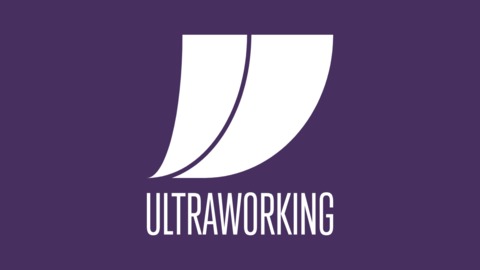
Ultraworking is the pricier option. Ultraworking offers a rolling schedule of 24/7 Zoom sessions, which they call work cycles, so that users don’t have to wait for a pre-scheduled session. The cost is $49//month, billed quarterly.
Whether you prefer a carrot or stick, whether you’d rather work with an individual or a group, whether you select a free option or pay to increase your commitment), I hope you find one or more accountability solutions to help you push through your procrastination and achieve your goals.
If you have an accountability tool or success story not mentioned here, please share in the comments section. And for more to help you be productive, be sure to check back for my next post, Flow and Faux (Accountability): Productivity, Focus, and Alex Trebek.

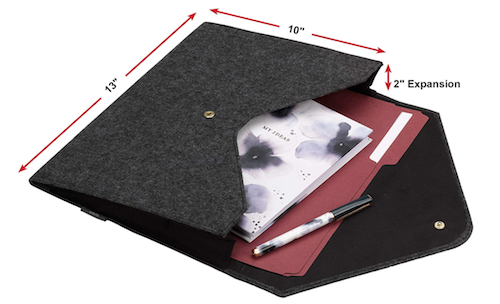

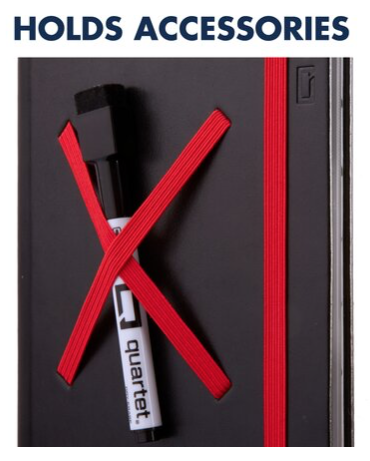

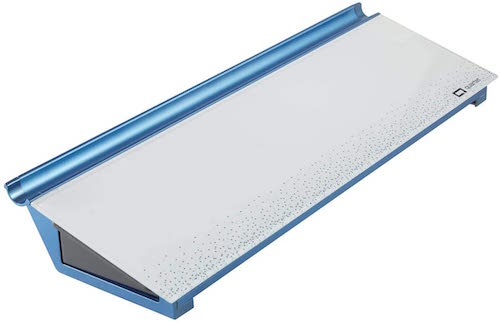

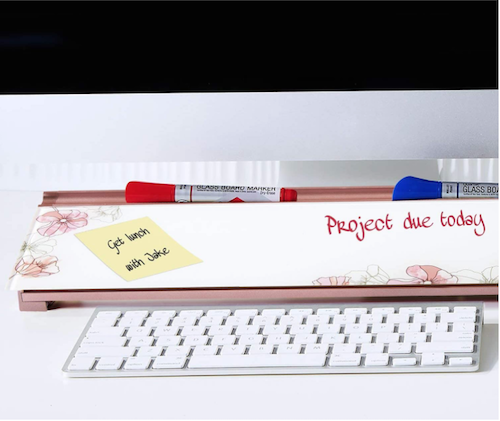
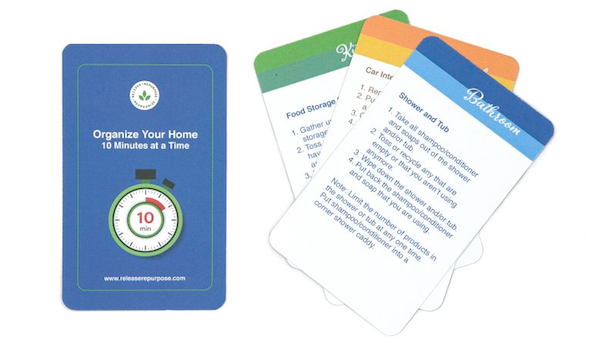
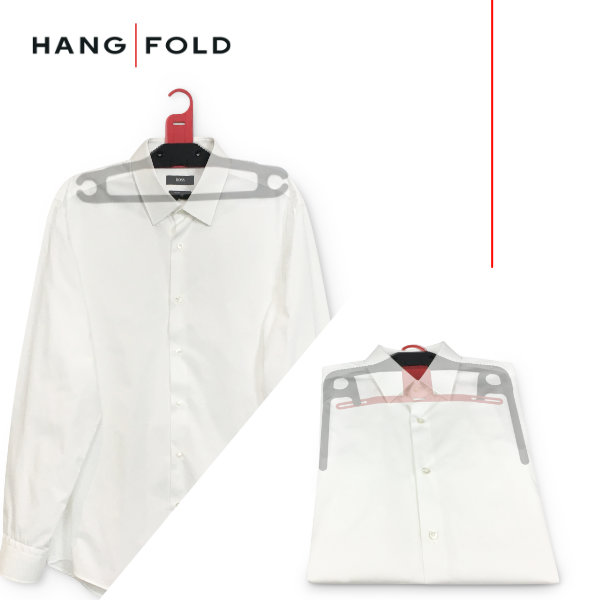





Follow Me